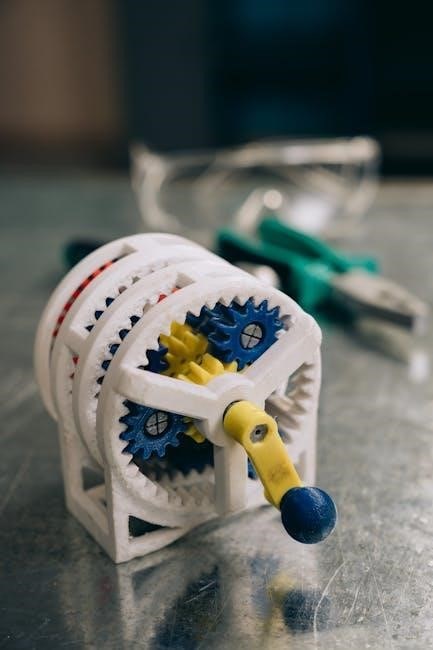Understanding washing machine parts is essential for effective maintenance and troubleshooting. This guide provides a detailed overview, helping you identify components and their functions for optimal performance. A PDF guide is a valuable resource for visual identification and DIY repairs.
1.1 Importance of Understanding Washing Machine Components
Understanding washing machine components is crucial for effective troubleshooting and maintenance. Knowing how each part functions ensures optimal performance and extends the machine’s lifespan. Familiarizing yourself with parts like the motor, tub, and control panel helps diagnose issues quickly. A PDF guide with pictures provides clear visuals, aiding in identifying components and their roles. This knowledge empowers users to perform DIY repairs and avoid costly professional interventions, ensuring efficient and economical appliance management.
1.2 Brief Overview of Key Parts and Their Functions
A washing machine consists of essential parts like the control panel, motor, drum, and tub. The control panel manages settings and cycles, while the motor powers the drum’s rotation for washing and spinning. The drum holds clothes, and the tub contains water. The agitator or impeller aids in cleaning clothes, and the detergent dispenser releases detergent during cycles. Understanding these components and their roles is vital for proper maintenance and troubleshooting. A PDF guide with pictures provides a clear visual reference for identifying and understanding each part’s function.
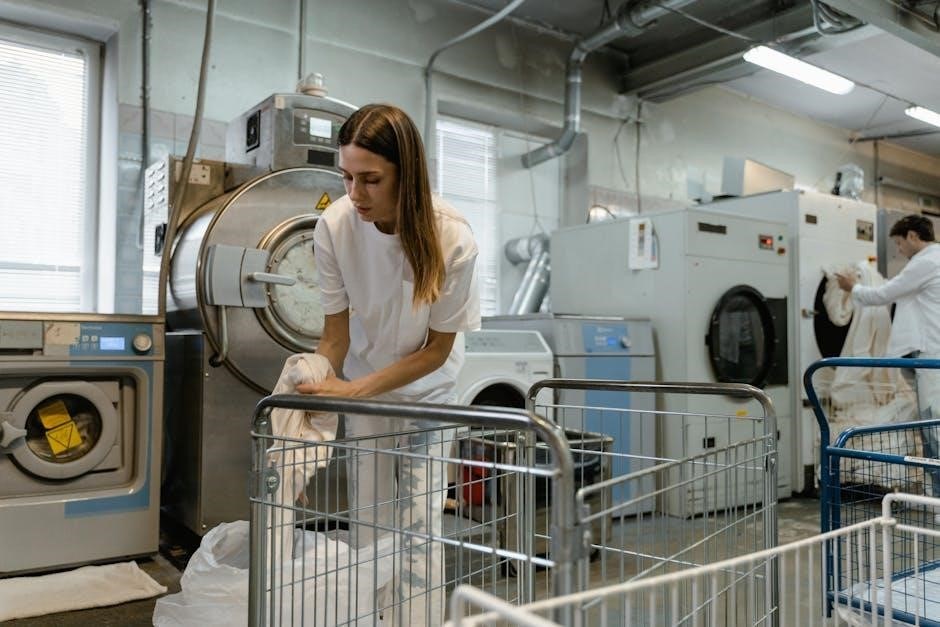
Exterior Parts of a Washing Machine
The exterior includes the control panel, lid, and detergent dispenser. These parts are essential for operation and user interaction, ensuring efficient and safe washing cycles.
2.1 Control Panel: Functions and Features
The control panel is the user interface of the washing machine, featuring buttons, dials, or a digital display. It allows selection of wash cycles, temperature settings, and spin speed. Modern panels may include touchscreens and smart connectivity. Sensors within the panel detect user inputs and relay them to the circuit board, ensuring precise control over the washing process. Maintenance involves cleaning the panel and updating software for optimal performance.
2.2 Lid or Door: Design and Safety Mechanisms
The lid or door of a washing machine is designed for easy loading and unloading of laundry while ensuring a watertight seal during operation. Modern models feature safety mechanisms like lid switches that prevent the machine from running when the lid is open. Some doors include locking systems to avoid accidental opening during cycles. Proper maintenance, such as cleaning door seals, is essential to prevent mold and mildew buildup, ensuring long-term functionality and hygiene.
2.3 Detergent Dispenser: Purpose and Maintenance
The detergent dispenser is a compartment designed to hold laundry detergent, ensuring it is released at the correct time during the wash cycle. Proper use enhances cleaning efficiency by distributing detergent evenly. Regular maintenance, such as cleaning the dispenser drawer and checking for blockages, prevents residue buildup and mold growth. This simple upkeep ensures optimal performance and fresh-smelling laundry. Always refer to your washing machine’s manual for specific care instructions tailored to your model.
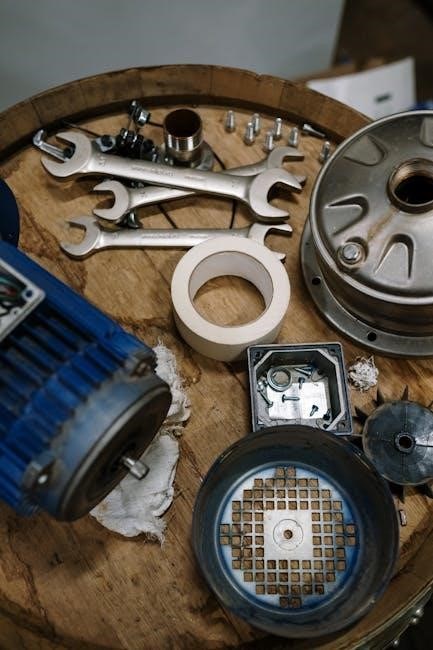
Interior Parts of a Washing Machine
The interior includes the tub, drum, and agitator or impeller, each playing a crucial role in washing and rinsing clothes efficiently. Proper functioning ensures smooth operation and cleanliness.
3.1 Tub: Role in Washing and Rinsing
The tub is a critical component where the washing and rinsing processes occur. It holds the water and clothes, ensuring proper agitation and drainage. The tub’s durability and design directly impact the machine’s efficiency and longevity. Regular maintenance, such as cleaning and checking for leaks, is essential to prevent damage and optimize performance. A well-maintained tub ensures effective washing and rinsing cycles, keeping your clothes clean and extending the machine’s lifespan.
3.2 Drum: Construction and Functionality
The drum is the rotating chamber where clothes are placed for washing. Constructed from durable materials like stainless steel or coated steel, it withstands repeated use and harsh washing conditions. The drum’s design includes holes or lifters to circulate water and detergent, ensuring clothes move evenly during cycles. Its smooth interior prevents fabric damage, while its robust construction supports high spin speeds. Regular cleaning and inspection of the drum are essential to maintain hygiene and performance. Refer to a PDF guide for detailed visuals and maintenance tips.
3.3 Agitator or Impeller: Differences and Purposes
The agitator and impeller are key components in a washing machine responsible for moving clothes during the wash cycle. The agitator, typically found in top-loading machines, is a tall, finned column that twists to agitate clothes, ensuring thorough cleaning. In contrast, the impeller, used in many front-loading and some top-loading models, is a smaller, rotating disc or finned plate that gently moves clothes without the aggressive action of an agitator. Both designs aim to distribute detergent and water evenly, but the impeller is generally quieter and gentler on fabrics. Refer to a PDF guide for detailed visuals and comparisons.
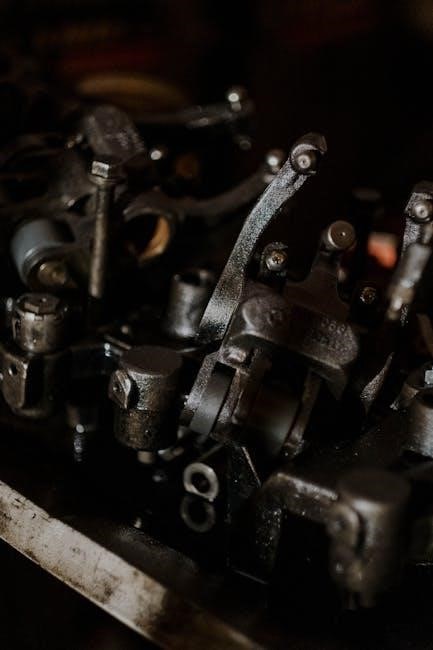
Mechanical Components
Mechanical components like the motor, pulley, belt, and gearbox work together to power the washing machine’s operations; These parts enable spinning, agitation, and cycle transitions efficiently.
4.1 Motor: Types and Functions
The motor is the heart of the washing machine, powering the drum’s rotation during wash and spin cycles. Common types include AC, DC, and brushless motors, each offering unique efficiency and noise levels. The motor’s function is to convert electrical energy into mechanical energy, driving the agitator or impeller for washing and the drum for spinning. Modern models often use direct-drive motors, eliminating belts for reduced vibration and higher efficiency. Understanding motor types and functions aids in troubleshooting and maintenance, ensuring optimal performance and longevity.
4.2 Belt and Pulley System: Operation and Replacement
The belt and pulley system connects the motor to the washing machine’s drum, transmitting power for rotation. Over time, belts can wear out or crack, leading to noise or operational issues. Replacement involves removing the old belt and fitting a new one, ensuring proper alignment with pulleys. Regular inspection and timely replacement prevent sudden breakdowns. This system is crucial for smooth operation, but newer models often replace belts with direct-drive mechanisms for enhanced durability and quieter performance.
4.3 Gearbox or Transmission: Role in Agitation and Spin Cycles
The gearbox or transmission manages gear changes, enabling the washing machine to switch between agitation and spin cycles. It ensures smooth transitions, allowing the drum to alternate between slow and high-speed rotations. Over time, wear and tear can cause gearbox failure, leading to noisy operation or cycle interruption. Regular lubrication and inspection are crucial for maintaining its efficiency. Understanding its function is key for diagnosing issues and ensuring optimal performance in both wash and spin modes.
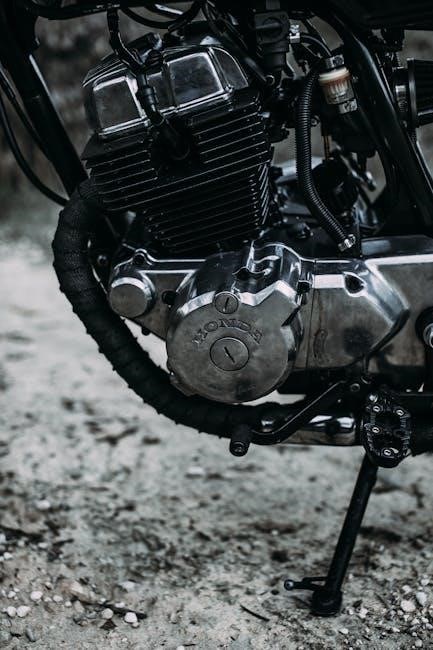
Electrical and Electronic Parts
Electrical components like the circuit board, sensors, and timer regulate wash cycles and ensure smooth operation. These parts work together to monitor and control the machine’s functions efficiently.
5.1 Circuit Board: The Brain of the Washing Machine
The circuit board serves as the central control unit of the washing machine. It processes inputs from sensors and user selections to regulate wash cycles, temperature, and spin speed. Acting as the brain, it ensures all parts operate in harmony. Damages to the circuit board can disrupt the machine’s functionality, requiring professional repair or replacement; A PDF guide can help identify and troubleshoot issues related to this critical component.
5.2 Sensors: Temperature, Water Level, and Load Detection
Sensors in a washing machine monitor temperature, water levels, and load size. They ensure optimal performance by detecting imbalances and adjusting cycles accordingly. Temperature sensors prevent overheating, while water level sensors maintain the correct fill volume. Load detection sensors adjust wash cycles based on fabric type and weight. These sensors work in tandem with the circuit board to ensure efficient operation. Faulty sensors can lead to poor wash performance, making them crucial for troubleshooting. A PDF guide can help identify and diagnose sensor-related issues effectively.
5.3 Timer and Program Selector: How They Control Wash Cycles
The timer and program selector are essential for managing wash cycles. The timer regulates the duration of each cycle, ensuring precise control over washing, rinsing, and spinning phases. The program selector allows users to choose specific settings for fabric type, soil level, and temperature. Together, they synchronize with sensors and the motor to optimize performance. A faulty timer or selector can disrupt cycles, making them critical for troubleshooting. A PDF guide can provide detailed diagrams to help identify and repair these components effectively, ensuring smooth operation.
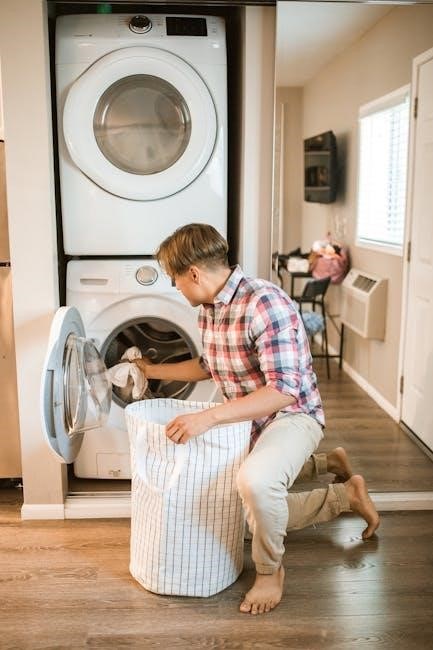
Water and Drainage System
The water and drainage system includes inlet valves, drain pump, and hoses, ensuring proper water supply and drainage during wash cycles.
6.1 Water Inlet Valves: Hot and Cold Water Supply
The water inlet valves regulate the supply of hot and cold water into the washing machine. They are typically located at the back of the machine and connected to the water hoses. These valves are controlled by the machine’s electronic system, ensuring the correct temperature and water level for each cycle. Proper maintenance, such as checking for leaks or mineral buildup, is essential to prevent issues like reduced water flow or valve failure. Regular cleaning and replacement of worn-out parts can extend their lifespan.
6.2 Drain Pump: Functionality and Common Issues
The drain pump is responsible for removing water from the washing machine tub after each cycle. It is typically located at the bottom of the machine and is connected to the motor via a belt or direct drive. Common issues include clogs from debris like lint or coins, which can block the pump and cause water to remain. A faulty drain pump may also produce loud noises or leak water. Regular cleaning of the pump filter and checking for blockages can prevent these issues. If damaged, the pump may need replacement, a common DIY repair.
6.3 Hose and Connectors: Importance and Maintenance
The hoses and connectors in a washing machine are essential for supplying water and draining it after cycles. They connect the water inlet valves to the tub and the drain pump to the exterior drainage system. Over time, hoses can develop leaks or become brittle due to mineral buildup or wear. Regular inspection and tightening of connectors can prevent water damage. Replacing hoses every 5 years is recommended to avoid sudden failures. Proper maintenance ensures reliable operation and prevents costly repairs.
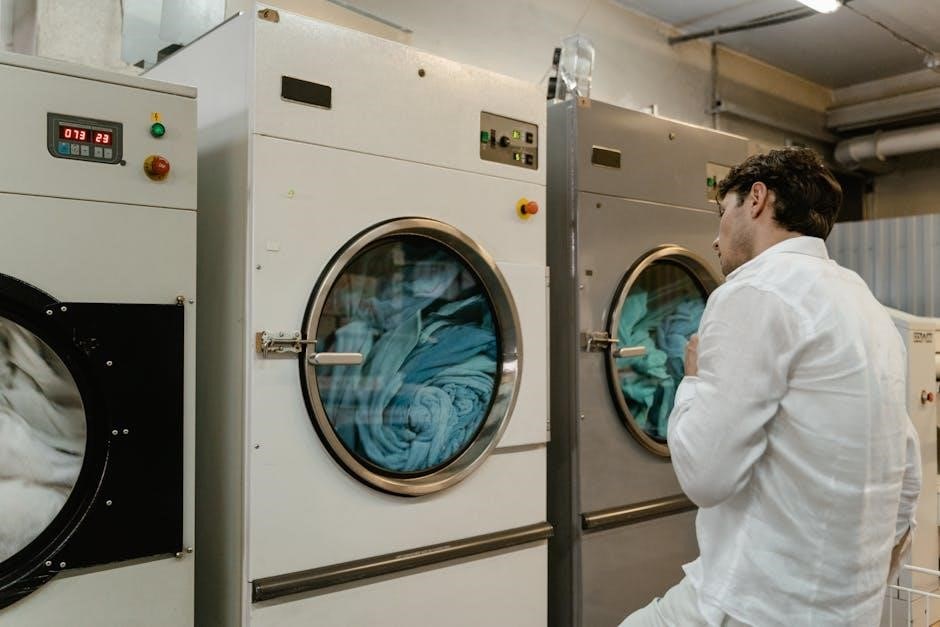
Safety Features
Safety features in washing machines include lid switches, child locks, and overload protection. These components prevent accidents, ensure safe operation, and protect users from potential hazards during use.
7.1 Lid Switch: Ensuring Safe Operation
The lid switch is a critical safety component in washing machines. It ensures the machine stops operation when the lid is opened, preventing accidents. This mechanism interrupts power to the motor and other components, safeguarding users from moving parts. The lid switch is usually located near the lid or door and is essential for preventing injuries and ensuring safe operation. Regularly checking its functionality is vital to maintain safety standards and prevent potential hazards during use.
7.2 Child Lock: Preventing Accidental Start
The child lock is a safety feature designed to prevent accidental operation of the washing machine by children. It disables the control panel buttons, ensuring the machine only starts when authorized. This feature is especially useful for households with young children, providing peace of mind and protecting both the child and the appliance from unintended use. The child lock can usually be activated through a specific button combination or setting, making it a crucial component for safe and secure operation.
Overload protection is a critical safety feature that prevents motor damage by detecting excessive weight or imbalance in the washing machine. It automatically stops the machine if the load exceeds safe limits, safeguarding the motor from overheating or mechanical stress; This mechanism ensures smooth operation and extends the lifespan of the appliance. Modern washing machines often incorporate sensors or thermal overload protectors to monitor and respond to potential overloads, making it an essential component for reliable performance and longevity.
Washing Machine Parts Diagram
7.3 Overload Protection: Preventing Motor Damage
Overload protection is a critical safety feature that prevents motor damage by detecting excessive weight or imbalance in the washing machine. It automatically stops the machine if the load exceeds safe limits, safeguarding the motor from overheating or mechanical stress. This mechanism ensures smooth operation and extends the lifespan of the appliance. Modern washing machines often incorporate sensors or thermal overload protectors to monitor and respond to potential overloads, making it an essential component for reliable performance and longevity.
8.1 Understanding the Layout of a Washing Machine
Understanding the layout of a washing machine is crucial for identifying its components and their functions. A detailed parts diagram provides a visual representation of the machine’s structure, highlighting key sections like the exterior, interior, and mechanical systems. This layout helps users locate parts such as the control panel, tub, drum, and motor. By referencing a PDF guide with labeled images, you can better comprehend how each part interacts within the machine, facilitating repairs and maintenance. This visual aid simplifies troubleshooting and enhances overall familiarity with the appliance’s design.
8.2 Visual Identification of Key Components
A PDF guide with detailed diagrams and labeled images allows for easy visual identification of washing machine parts. Clear illustrations highlight components like the control panel, tub, drum, and motor, making it simpler to recognize and locate each part. This visual approach aids in understanding the machine’s structure and helps users identify components for maintenance or repairs. The images, often accompanied by descriptions, provide a practical reference for DIY enthusiasts and professionals alike, ensuring accurate identification and efficient troubleshooting. This resource is invaluable for both novices and experienced users.
8.3 How to Use a Diagram for Troubleshooting
Using a washing machine parts diagram for troubleshooting involves identifying the faulty component visually. Start by locating the problematic area on the diagram, then cross-reference it with the actual machine. Check connections, belts, and sensors for damage or misalignment. This visual guide helps diagnose issues efficiently, ensuring accurate repairs. By following the diagram, users can pinpoint malfunctions quickly, whether it’s a broken belt or a faulty sensor, and address them effectively to restore functionality.
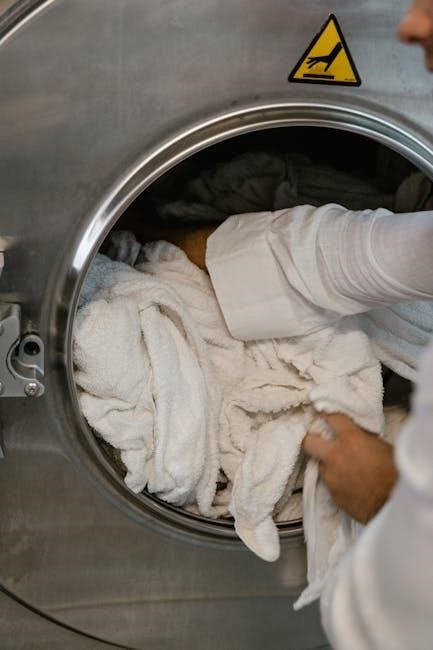
PDF Guide to Washing Machine Parts
A PDF guide provides a comprehensive visual catalog of washing machine parts, including names, images, and functions. It aids in identification and DIY repairs effectively.
9.1 Benefits of a PDF Guide for Identification
A PDF guide offers clear benefits for identifying washing machine parts. It provides high-quality images and detailed descriptions, making it easier to recognize components. The visual catalog helps users match parts with their functions, reducing confusion. Additionally, the guide is easily searchable and portable, allowing quick reference during repairs. This resource is invaluable for DIY enthusiasts and professionals alike, ensuring accurate identification and efficient troubleshooting of washing machine parts.
9.2 How to Download and Use a Parts Catalog
To download a washing machine parts catalog, visit the manufacturer’s official website and search for your specific model. Most catalogs are available in PDF format for easy access. Once downloaded, use the bookmarks or search function to navigate through sections. The catalog typically includes detailed diagrams, part numbers, and descriptions. This makes it easier to identify components visually and troubleshoot issues. Regularly updated catalogs ensure accuracy, making them a reliable tool for maintenance and repairs.
9.3 Key Features of a Comprehensive PDF Guide
A comprehensive PDF guide on washing machine parts includes detailed diagrams, part numbers, and descriptions. It features a user-friendly layout with searchable content, making it easy to locate specific components. High-resolution images and labeled illustrations help in visual identification. The guide often includes troubleshooting tips and maintenance advice. Regular updates ensure the information stays relevant and accurate. This resource is indispensable for DIY repairs and understanding how each part contributes to the machine’s functionality, enhancing overall maintenance efficiency.
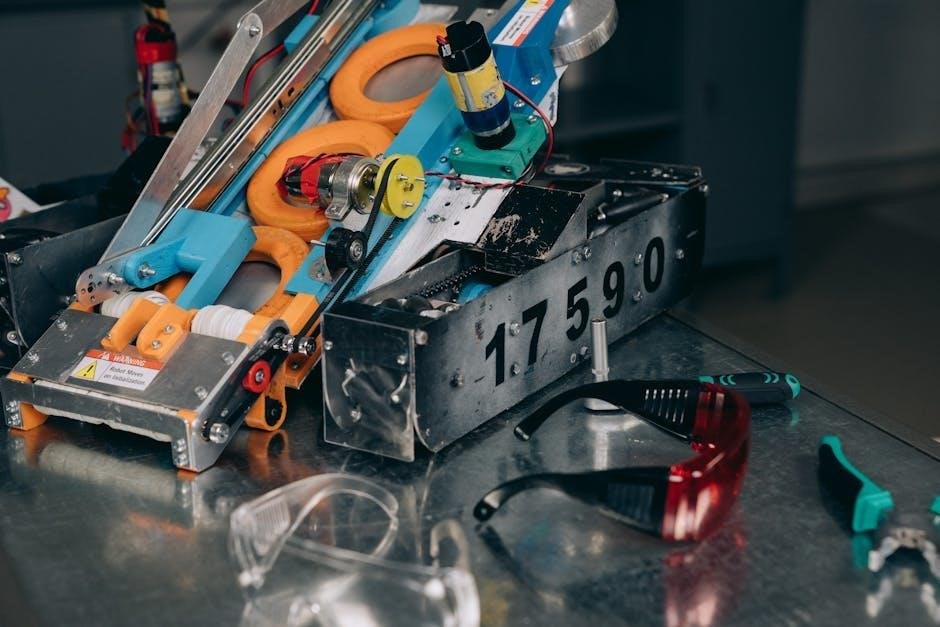
Maintenance and Repair Tips
Regular cleaning of filters and gaskets prevents mold buildup. Check belts and hoses for wear. Referencing a parts diagram aids in identifying and replacing faulty components efficiently.
10.1 Regular Cleaning of Parts for Optimal Performance
Regular cleaning of washing machine parts ensures optimal performance. The detergent dispenser and gasket should be cleaned monthly to remove residue. Filters in the drain pump prevent clogs and odors. Check and clean the tub regularly to avoid mold buildup. Referencing a parts diagram helps locate these components easily. Keeping parts clean extends the machine’s lifespan and prevents costly repairs. A well-maintained machine runs more efficiently and effectively.
10.2 DIY Repairs: Replacing Common Parts
Replacing common washing machine parts can save time and money. Start by identifying the faulty component using a parts diagram. The belt, for instance, is easy to replace if damaged. Disconnect power, remove the old belt, and fit the new one. Similarly, the drain pump filter can be cleaned or replaced if clogged. Ensure to purchase parts matching your machine’s model. Following a PDF guide or manual provides step-by-step instructions for safe and effective DIY repairs.
10.3 When to Call a Professional
If a problem exceeds your DIY skills, it’s wise to call a professional. Complex issues like faulty motors or electrical components require specialized tools and expertise. Ignoring these can lead to further damage or safety hazards. A professional can diagnose and repair issues efficiently, ensuring your washing machine operates safely and effectively. Always prioritize safety and efficiency by seeking expert help when needed to avoid costly breakdowns and extend the machine’s lifespan.

Common Faults and Troubleshooting
Identify faulty parts using symptoms like unusual noises or leaks. Troubleshoot with a parts diagram to diagnose issues quickly. Preventive measures can avoid breakdowns, ensuring smooth operation.
11.1 Identifying Faulty Parts Based on Symptoms
Identifying faulty parts begins with recognizing common symptoms like unusual noises, leaks, or vibrations. A noisy operation may indicate worn bearings or a damaged drum. Leaks often point to faulty gaskets or hoses. Unbalanced vibrations could signal issues with the tub or suspension system. By analyzing these symptoms, you can narrow down the problematic component. Referencing a parts diagram in a PDF guide helps visually pinpoint the location and function of each part, aiding in accurate diagnosis and repair.
11.2 How to Diagnose Issues Using the Parts Diagram
Diagnosing washing machine issues using a parts diagram involves matching symptoms to specific components. Start by identifying the symptom, such as a leaking tub or loud noise during operation. Cross-reference the symptom with the diagram to locate the relevant part, like a faulty gasket or worn motor bearings. Inspect the part visually or through testing, such as checking for blockages in the drain pump. This methodical approach helps pinpoint the root cause efficiently, ensuring accurate repairs and minimizing downtime.
11.3 Preventative Measures to Avoid Breakdowns
Regular maintenance is key to preventing washing machine breakdowns. Clean the detergent dispenser and gasket to prevent mold buildup. Check hoses for kinks or cracks and replace worn seals. Ensure the machine is balanced to avoid vibration damage. Run a cleaning cycle monthly to remove detergent residue. Refer to your PDF guide for specific maintenance schedules. These steps extend the machine’s life and ensure optimal performance, reducing the likelihood of costly repairs. Consistent upkeep guarantees reliability and efficiency for years to come.
12.1 Summary of Key Washing Machine Parts
A washing machine comprises essential parts like the motor, drum, control panel, and water inlet valves. The motor powers the drum, while the control panel manages settings. The drum holds clothes, and the agitator or impeller aids washing. Sensors and circuit boards ensure efficient operation. Familiarizing yourself with these components, as detailed in a PDF guide, helps in troubleshooting and maintenance, ensuring optimal performance and longevity of your appliance.
12.2 Importance of Familiarity with Parts for Maintenance
Familiarity with washing machine parts is crucial for effective maintenance and troubleshooting. Knowing the components helps identify issues early, preventing minor problems from becoming major repairs. It also enables DIY fixes and informed decisions when professional help is needed. A PDF guide with labeled diagrams can enhance understanding, ensuring proper care and extending the appliance’s lifespan. Regular maintenance of key parts, like filters and seals, can improve efficiency and reliability, saving time and money in the long run.
12.3 Final Thoughts on Extending the Life of Your Washing Machine
Regular maintenance and familiarity with washing machine parts are key to extending its lifespan. Cleaning filters, checking hoses, and ensuring proper loading can prevent wear and tear. Referencing a PDF guide with labeled diagrams helps identify and address issues early. By understanding and caring for each component, you can optimize performance, reduce repair costs, and enjoy a reliable appliance for years to come.
